Related Research Articles

The Times-Picayune/The New Orleans Advocate is an American newspaper published in New Orleans, Louisiana, since January 25, 1837. The current publication is the result of the 2019 acquisition of The Times-Picayune by the New Orleans edition of The Advocate, which began publication in 2013 as a response to The Times-Picayune switching from a daily publication schedule to a Wednesday/Friday/Sunday schedule in October 2012.
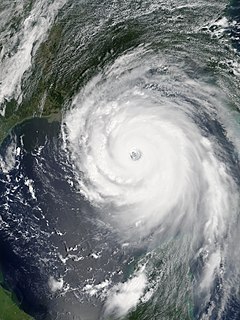
Hurricane Katrina was a destructive Category 5 Atlantic hurricane that caused over 1,800 fatalities and $125 billion in damage in late August 2005, especially in the city of New Orleans and the surrounding areas. It was at the time the costliest tropical cyclone on record and is now tied with 2017's Hurricane Harvey. The storm was the twelfth tropical cyclone, the fifth hurricane, and the third major hurricane of the 2005 Atlantic hurricane season, as well as the fourth-most intense Atlantic hurricane on record to make landfall in the contiguous United States.

As the center of Hurricane Katrina passed southeast of New Orleans on August 29, 2005, winds downtown were in the Category 1 range with frequent intense gusts. The storm surge caused approximately 23 breaches in the drainage canal and navigational canal levees and flood walls. As mandated in the Flood Control Act of 1965, responsibility for the design and construction of the city's levees belongs to the United States Army Corps of Engineers and responsibility for their maintenance belongs to the Orleans Levee Board. The failures of levees and flood walls during Katrina are considered by experts to be the worst engineering disaster in the history of the United States. By August 31, 2005, 80% of New Orleans was flooded, with some parts under 15 feet (4.6 m) of water. The famous French Quarter and Garden District escaped flooding because those areas are above sea level. The major breaches included the 17th Street Canal levee, the Industrial Canal levee, and the London Avenue Canal flood wall. These breaches caused the majority of the flooding, according to a June 2007 report by the American Society of Civil Engineers. The flood disaster halted oil production and refining which increased oil prices worldwide.
The article covers the Hurricane Katrina effects by region, within the United States and Canada. The effects of Hurricane Katrina, in late August 2005, were catastrophic and widespread. It was one of the deadliest natural disasters in U.S. history, leaving at least 1,836 people dead, and a further 135 missing. The storm was large and had an effect on several different areas of North America.
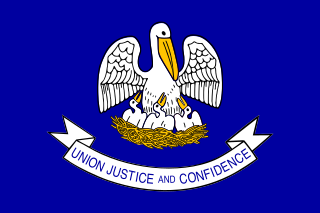
Criticism of the government response to Hurricane Katrina was a major political dispute in the United States in 2005 that consisted primarily of condemnations of mismanagement and lack of preparation in the relief effort in response to Hurricane Katrina and its aftermath. Specifically, there was a delayed response to the flooding of New Orleans, Louisiana.
Hurricane Katrina had many social effects, due the significant loss and disruption of lives it caused. The number of fatalities, direct and indirect, related to Katrina is 1,833 and over 400,000 people were left homeless. The hurricane left hundreds of thousands of people without access to their homes or jobs, it separated people from relatives, and caused both physical and mental distress on those who suffered through the storm and its aftermath, such as Post-traumatic stress disorder (PTSD).

Hurricane Katrina's winds and storm surge reached the Mississippi coastline on the morning of August 29, 2005. beginning a two-day path of destruction through central Mississippi; by 10 a.m. CDT on August 29, 2005, the eye of Katrina began traveling up the entire state, only slowing from hurricane-force winds at Meridian near 7 p.m. and entering Tennessee as a tropical storm. Many coastal towns of Mississippi had already been obliterated, in a single night. Hurricane-force winds reached coastal Mississippi by 2 a.m. and lasted over 17 hours, spawning 11 tornadoes and a 28-foot storm surge flooding 6–12 miles (10–19 km) inland. Many, unable to evacuate, survived by climbing to attics or rooftops, or swimming to higher buildings and trees. The worst property damage from Katrina occurred in coastal Mississippi, where all towns flooded over 90% in hours, and waves destroyed many historic buildings, with others gutted to the 3rd story. Afterward, 238 people died in Mississippi, and all counties in Mississippi were declared disaster areas, 49 for full federal assistance. Regulations were changed later for emergency centers and casinos. The emergency command centers were moved higher because all 3 coastal centers flooded at 30 ft (9 m) above sea level. Casinos were allowed on land rather than limited to floating casino barges as in 2005.

This article contains a historical timeline of the events of Hurricane Katrina on August 23–30, 2005 and its aftermath.
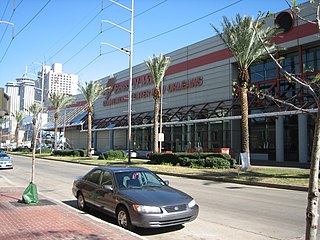
The Ernest N. Morial Convention Center is located in Downtown New Orleans, Louisiana, United States. The lower end of building one is located 1,640 feet (500 m) upriver from Canal Street on the banks of the Mississippi River. It is named after former Mayor of New Orleans Ernest Nathan Morial.
Aaron Francis Broussard was an American politician who served as the president, a combined municipal-parish position, of Jefferson Parish, Louisiana, from 2003 to 2010. A Democrat, Broussard became known nationally for appearances he made in the aftermath of Hurricane Katrina.
The Audubon Nature Institute is a family of museums and parks dedicated to nature and based in New Orleans, Louisiana.

Ochsner Baptist Medical Center is a hospital in New Orleans, Louisiana. The complex of hospital buildings is located on Napoleon Avenue in Uptown New Orleans.

Malik Rahim is an American housing and prison activist based since the late 1990s in the New Orleans area of Louisiana, where he grew up. In 2005 Rahim gained national publicity as a community organizer in New Orleans in 2005 to combat the widespread destruction in the aftermath of Hurricane Katrina; there he co-founded the Common Ground Collective.

Many representatives of the news media reporting on the aftermath of Hurricane Katrina became directly involved in the unfolding events, instead of simply reporting. Due to the loss of most means of communication, such as land-based and cellular telephone systems, field reporters in many cases became conduits for information between victims and authorities.
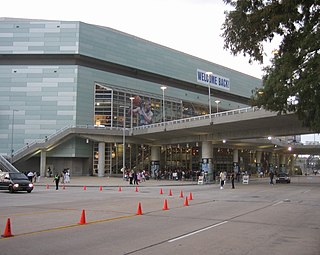
When the Levees Broke: A Requiem in Four Acts is a 2006 documentary film directed by Spike Lee about the devastation of New Orleans, Louisiana following the failure of the levees during Hurricane Katrina. It was filmed in late August and early September 2005, and premiered at the New Orleans Arena on August 16, 2006 and was first aired on HBO the following week. The television premiere aired in two parts on August 21 and 22, 2006 on HBO. It has been described by Sheila Nevins, chief of HBO's documentary unit, as "one of the most important films HBO has ever made." The title is a reference to the blues tune "When the Levee Breaks" by Kansas Joe McCoy and Memphis Minnie about the Great Mississippi Flood of 1927.
Gulfsails is the name of a blog, written by Troy Gilbert, that documented the effect of Hurricane Katrina on New Orleans following that disaster. In the early aftermath of the hurricane and the 2005 levee failures in Greater New Orleans, it was one of the few reliable communications links between the city and the rest of the world.
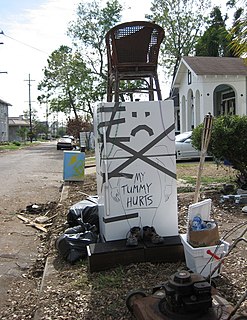
Katrina refrigerators are refrigerators that were destroyed or rendered unusable during Hurricane Katrina on August 29, 2005, and their aftermath. Many were made into temporary folk art.

The Louisiana Superdome was used as a "shelter of last resort" for those in New Orleans unable to evacuate from the city when Hurricane Katrina struck on August 29, 2005.

A.D.: New Orleans After the Deluge is a non-fiction graphic novel by cartoonist Josh Neufeld. Originally published as a webcomic, A.D. tells the stories of a handful of real-life New Orleans residents and their experiences during and after Hurricane Katrina. The graphic novel was a New York Times best-seller and was nominated for an Eisner Award and a Harvey Award in 2010. In addition, A.D. was selected for inclusion in The Best American Comics 2010.
The United States Army Corps of Engineers is involved with a wide spectrum of public works projects: environmental protection, water supply, recreation, flood damage and reduction, beach nourishment, homeland security, military construction, and support to other Governmental agencies. In nineteen (19) different Flood Control Acts since 1917, the United States Congress has authorized the corps to design and build flood protection projects and one risk reduction system in the Greater New Orleans area and throughout the nation.
References
- 1 2 Silberman, Steve (November 2005). "Hurricane Heroics". Wired . Vol. 13, no. 11.
- ↑ Jardin, Xeni (September 19, 2005). "CNN Hacks New TV Technology". Wired .
- ↑ Running, Daniel (December 31, 2005). "Top Ten Web Moments of 2005". DownloadSquad.com. Archived from the original on January 3, 2006.
- ↑ Tynan, Dan (October 1, 2007). "The 16 Greatest Moments in Web History". PC World .
- ↑ "Interdictor: Profile". Livejournal.com. July 23, 2010. Archived from the original on June 27, 2007.